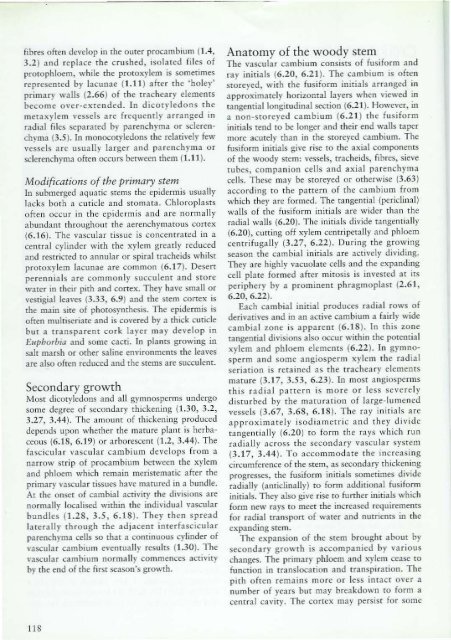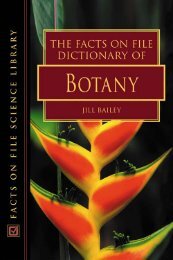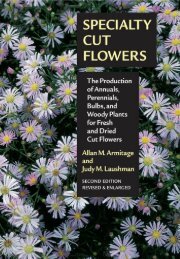You also want an ePaper? Increase the reach of your titles
YUMPU automatically turns print PDFs into web optimized ePapers that Google loves.
fibres often develop in the outer procnmbium (1.4,<br />
3.2) and replace the crushed, isolated files of<br />
prorophloem, while the protoxylem is sometimes<br />
represented by lacunae (1.11) after the 'hole}"<br />
primary walls (2.66) of the rrachcary elements<br />
become over-extended. In dicotyledons the<br />
metaxylem vessels are frequently arranged in<br />
radial files separated by parenchyma or sclerenchyma<br />
(3.5)_ In monocotyledons the relatively few<br />
vessels arc usually larger and parenchyma or<br />
sclerenchyma often occurs benveen them (1.11).<br />
Modifications ofthe primary stem<br />
In submerged aquatic stems the epidermis usually<br />
lacks both a cuticle and stomara. Chloroplasts<br />
often occur in the epidermis and tHe normally<br />
abundant throughout the aerenchymatous cortex<br />
(6.16). The vascular tissue is concentrated in a<br />
central cylinder with the xylem greatly reduced<br />
and restricted to annular or spiral tracheids whilst<br />
protoxylcm lacunae are common (6.17). Desert<br />
perennials are commonly succulent and store<br />
water in their pith and cortex. They have small or<br />
vestigial leaves (3.33, 6.9) and the stem cortex is<br />
the main site of photosynthesis. The epidermis is<br />
often multiseriatc and is covered by a thick cuticle<br />
but a transparent cork layet may develop in<br />
£If!Jhorbia and some cacti. In plants growing in<br />
salt marsh or other saline environments the leaves<br />
are also often reduced and the stems are succulent.<br />
Secondary growth<br />
Most dicotyledons and all gymnosperms undergo<br />
some degree of secondary thickening (1.30, 3.2,<br />
3.27,3.44). The alllouO[ of thickening produced<br />
depends upon whether the mature plant is herbaceous<br />
(6.18, 6.19) or arborescent (1.2, 3.44). The<br />
fascicular vascular cambium de ....elops from a<br />
narrow strip of procambium between the xylem<br />
and phloem which remain meristematic after the<br />
primary vascular tissues have matured in a bundle.<br />
At the onset of cambial acti\·iry the divisions are<br />
normally localised within the individual vascular<br />
bundles (1.28, 3.5, 6.18). They then spread<br />
laterally through the adjacent interfascicular<br />
parenchyma cells so that a continuous cylinder of<br />
vascular cambium eventually results (1.30). The<br />
vascular cambium normally commences activity<br />
by the end of the first season's growth.<br />
118<br />
Anatomy of the woody stem<br />
The vascular cambium consists of fusiform and<br />
ray initials (6.20, 6.21). The cambium is often<br />
storeyed, with the fusiform initials arranged in<br />
approximately horizontal layers when viewed in<br />
tangential longitudinal section (6.21). However, in<br />
a non-srore)'ed cambium (6.21) the fusiform<br />
initials tend to be longer and their end walls taper<br />
more acutely than in the storeyed cambium. The<br />
fusiform initials give rise to the axial components<br />
of the woody stem: vessels, tracheids, fibres, sie ....e<br />
rubes, companion cells and axial parenchyma<br />
cells. These may be storeyed or otherwise (3.63)<br />
according to the patrern of the cambium from<br />
which they arc formed. The tangenrial (periclinal)<br />
walis of the fusiform initials are wider than the<br />
radial walls (6.20). The initials divide tangentially<br />
(6.20), cuning off xylem centripetally and phloem<br />
centrifugally (3.27, 6.22). During the gtowing<br />
season the cambial initials are actively dividing.<br />
They are highly vacuolate cells and the expanding<br />
cell plate formed after mitosis is invested at its<br />
periphery by a prominent phragmoplast (2.61,<br />
6.20,6.22).<br />
Each cambial initial produces radial rows of<br />
derivatives and in an acti ....e cambium a fairly wide<br />
cambial zone is apparent (6.1 S). In this zone<br />
tangential divisions also occur within rhe potential<br />
xylem and phloem elements (6.22). In gymnosperm<br />
and some angiosperm xylem tbe radial<br />
seriation is retained as the trachear}' e1emenrs<br />
mature (3.17, 3.53, 6.23). In mosr angiosperms<br />
this radial pattern is more or less severely<br />
disturbed by the maturation of large-lumencd<br />
vessels (3.67, 3.6S, 6.18). The r.:'ly inirials arc<br />
approximately isodiamctric .:'Ind they divide<br />
tangentially (6.20) to form the rays which run<br />
radially across the secondary vascular system<br />
(3.17, 3.44). To accommodate the increasing<br />
circumference of the stem, as secondary thickening<br />
progresses, the fusiform initials sometimes divide<br />
radially (anticlinally) to form additiollal fusiform<br />
initials. They also give rise to further initials which<br />
form new rays to meet the increased requirements<br />
for radial transport of water and nutrients in the<br />
expanding srem.<br />
The expansion of the stem brought about by<br />
secondary growth is accompanied by various<br />
changes. The primary phloem and xylem cease to<br />
function in translocation and mlilspiration. The<br />
pith often remains more or less inract over a<br />
number of years but may breakdown ro form a<br />
central cavity. The cortex may persist for some





